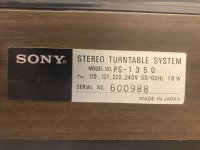Hello all,
I want to ask your advise. It's about a turntable. I picked up one a few weeks ago. Cleaned it up, oiled, changed the belt, etc. Looks and works fine ... except for one thing.
I didn't notice that at once, only recently my ear raised a concern. Music sounded a bit faster on this player than on the other. Quick check by the RPM app revealed the reason - 35.5 rpm. No pitch control on this player, no strobe. It is a Sony PS-1350 with a 4-pole synchronous motor. Apparently it picks up its speed from the mains frequency. Mine as expected is solid 60 Hz. If that motor expects 50 Hz - that would explain the slight speed increase.
Any ideas how to correct/fix this?
Thanks.
I want to ask your advise. It's about a turntable. I picked up one a few weeks ago. Cleaned it up, oiled, changed the belt, etc. Looks and works fine ... except for one thing.
I didn't notice that at once, only recently my ear raised a concern. Music sounded a bit faster on this player than on the other. Quick check by the RPM app revealed the reason - 35.5 rpm. No pitch control on this player, no strobe. It is a Sony PS-1350 with a 4-pole synchronous motor. Apparently it picks up its speed from the mains frequency. Mine as expected is solid 60 Hz. If that motor expects 50 Hz - that would explain the slight speed increase.
Any ideas how to correct/fix this?
Thanks.
You would have to either change the motor or the pulley.
There might also be a variable frequency drive board available that could work with it.
There might also be a variable frequency drive board available that could work with it.
Last edited:
You probably just have the wrong belt thickness. Guessing you bought a generic replacement belt?If that motor expects 50 Hz - that would explain the slight speed increase.
jeff
Regretfully, it disintegrated.Can you try the original belt again?
This should work, and is cheap if it fixes the problem. If not, it's a spare belt that you'll need some day.
https://www.amazon.com/Turntable-Belt-Sony-PS-1350/dp/B071W1Z9RN
https://www.amazon.com/Turntable-Belt-Sony-PS-1350/dp/B071W1Z9RN
I tried to increase the diameter of the platter circle where the belt runs, with a few small belts which were snug there. That was supposed to slow down the rotation at least a bit. Not a chance.You probably just have the wrong belt thickness. Guessing you bought a generic replacement belt?
jeff
My understanding is the the motor is meant to run on both frequencies. It obviously is not that intelligent to figure this out on its own. There must be some other circuit to deal with this. Am I right?
Yep. And I couldn't find any tips in the service manual. 😢The specs say the Sony PS-1350 is a 50/60 Hz model.
If there is no internal switch, then it must automatically run at the right speed on either frequency.
I bought mine at ebay. Also described as being for PS-1350.This should work, and is cheap if it fixes the problem. If not, it's a spare belt that you'll need some day.
https://www.amazon.com/Turntable-Belt-Sony-PS-1350/dp/B071W1Z9RN
Do you have an idea where that might be?Hi,
If it was 50hz motor running on 60hz, rpm would be 40, must be something else
Yep. And I couldn't find any tips in the service manual. 😢
The manual is confusing, but appears to say the Sony PS-1350 is 60Hz only.
I must have missed that one.The manual is confusing, but appears to say the Sony PS-1350 is 60Hz only.
But 60 Hz is what it has now.
Looks like there were several versions, USA & Canada were 120v, 60Hz only. Some had a switchable voltage, 100v, 120v, 220v with a dual primary power transformer.The manual is confusing, but appears to say the Sony PS-1350 is 60Hz only.
There must have been a motor pulley adaptor for 50Hz operation.
jeff
Last edited:
I have to look inside one more time. I didn't see any switches.Some had a switchable voltage, 100v, 120v, 220v etc.
Attachments
USA & Canada models don't have switchable input voltage. Here's a snapshot of the service manual.

Well, if they don't have switches, there must be only two ways to adjust to different frequency:
a) mechanical, pulley or platter swap,
b) auto sensing circuit to slow down the rotation at 60 Hz
A) is highly unlikely, in my opinion.
a) mechanical, pulley or platter swap,
b) auto sensing circuit to slow down the rotation at 60 Hz
A) is highly unlikely, in my opinion.
It's "A", unless someone magically figured out how to turn 60Hz to 50Hz for a synchronous motor in 1975.
jeff
jeff
a small amplifier driving a 12V toroid transformer backwards, driven by an oscillator and you have variable speed. even a small chip amp can do it, probably 20 watts us about all you need
- Home
- Source & Line
- Analogue Source
- Turntable with a synchronous motor
